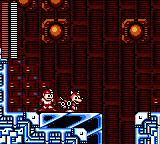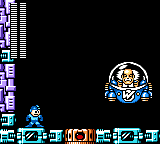Mega Man
From Sega Retro
| Mega Man | |||||||||||||||
|---|---|---|---|---|---|---|---|---|---|---|---|---|---|---|---|
| System(s): Sega Game Gear | |||||||||||||||
| Publisher: U.S. Gold | |||||||||||||||
| Developer: Freestyle Software[1] | |||||||||||||||
| Distributor: Ecofilmes (PT) | |||||||||||||||
| Licensor: Capcom | |||||||||||||||
| Genre: Action | |||||||||||||||
| Number of players: 1 | |||||||||||||||
|
Mega Man is a Sega Game Gear action platform game developed by Freestyle Software[1] and published by U.S. Gold. A standalone entry in the Mega Man series combining elements from the second, fourth, and fifth games, it was released exclusively in the United States and Portugal in late 1995.[2]
Contents
Story
Mega Man is a robot originally named Rock, created as a lab assistant by the scientist Dr. Light with Dr. Wily as his partner. Following treachery by Dr. Wily in which he reprogrammed most of Dr. Light's robots, Rock volunteered to be converted into a fighting robot to defend the world from Wily's violent robotic threats, thus becoming Mega Man.
In this game, Mega Man must defeat six Robot Masters before traveling to the Formidable Fortress to face Dr. Wily himself.
Gameplay
The game is an action platformer played as the android Mega Man, who must destroy the six Robot Masters that have been reprogrammed by Dr. Wily. Mega Man moves with ![]() and
and ![]() . He jumps with
. He jumps with ![]() and jumps higher the longer the button is held. He cannot duck but can slide along the ground with
and jumps higher the longer the button is held. He cannot duck but can slide along the ground with ![]() +
+![]() to evade enemies or fit through narrow passages. To accommodate the small screen size of the Game Gear, the player can use the D-Pad to move the camera around after holding
to evade enemies or fit through narrow passages. To accommodate the small screen size of the Game Gear, the player can use the D-Pad to move the camera around after holding ![]() for a few seconds, which can help avoid making blind jumps into hazards.
for a few seconds, which can help avoid making blind jumps into hazards.
Mega Man's primary weapon is his arm-mounted Mega Buster, which shoots energy pellets with ![]() . After defeating a Robot Master (the boss of a stage), Mega Man acquires the Robot Master's weapon. The player can switch weapons by pausing the game with START . Weapons besides the Mega Buster expend energy to use, which can be replenished through item pick-ups.
. After defeating a Robot Master (the boss of a stage), Mega Man acquires the Robot Master's weapon. The player can switch weapons by pausing the game with START . Weapons besides the Mega Buster expend energy to use, which can be replenished through item pick-ups.
Each Robot Master is weak to one particular weapon. Since the player can decide to play the first four stages in any order, there is an element of strategy to deciding the order in which to play the stages to best counter each Robot Master. After defeating all of the Robot Masters, Mega Man travels to Dr. Wily's Fortress to defeat him as well.
Mega Man's health is indicated by a gauge in the corner of the screen. He loses health when he takes damage from an enemy. Some obstacles, such as spikes or bottomless pit, destroy Mega Man regardless of how much health he has remaining. If he loses all of his health, he loses a life. If he loses all of his lives, the game ends. The game has no continues, but it has a password system. A hard mode is unlocked after completing the game.
Weapons
Items
| Small Weapon Capsule | |
|---|---|
| Restores a small amount of energy for the currently selected weapon. | |
| Large Weapon Capsule | |
| Restores a large amount of energy for the currently selected weapon. | |
| Small Energy Pellet | |
| Restores a small amount of health to Mega Man. | |
| Large Energy Pellet | |
| Restores a large amount of health to Mega Man. | |
| E-Tank | |
| Fully refills Mega Man's health. This item is stored and can be used at any time by pausing the game with START . | |
| M-Tank | |
| Refills Mega Man's health and the energy for all of his weapons. This item is stored and can be used at any time by pausing the game with START . | |
| 1-Up | |
| Gives the player an extra life. |
Stages
The first four stages can be played in any order. After they are completed, the remaining stages are played in order.
| Stone Man | |
|---|---|
| Map: 1️⃣ | |
| Stone Man's weakness is the Bomb weapon. Mega Man receives the Stone weapon after defeating him. This stage originally appeared in Mega Man 5. | |
| Napalm Man | |
| Map: 1️⃣ | |
| Napalm Man's weakness is the Bright weapon. Mega Man receives the Bomb weapon after defeating him. This stage originally appeared in Mega Man 5. | |
| Bright Man | |
| Map: 1️⃣ | |
| Bright Man's weakness is the Crash weapon. Mega Man receives the Bright weapon after defeating him. This stage originally appeared in Mega Man 4. | |
| Star Man | |
| Map: 1️⃣ | |
| Star Man's weakness is the Stone weapon. Mega Man receives the Crash weapon after defeating him. This stage originally appeared in Mega Man 5. | |
| Wave Man | |
| Map: 1️⃣ | |
| Wave Man has no weakness aside from the Mega Buster. Mega Man receives the Wave weapon after defeating him. This stage originally appeared in Mega Man 5. | |
| Toad Man | |
| Map: 1️⃣ | |
| Toad Man's weakness is the Wave weapon. Mega Man receives the Rain weapon after defeating him. This stage originally appeared in Mega Man 4. | |
| Wily Castle | |
| Map: 1️⃣ | |
| This stage is based on Quick Man's stage in Mega Man 2, and the Dr. Wily fight is taken from Mega Man 5. |
Production credits
- Programming: Michael Hart
- Graphics: Paul Gregory
- Additional Code: Paul Carter
- Producer: Richard Siddall
- Quality Assurance Lead Technicians: John Griffiths, Dan Wong
- Quality Assurance Technicians: Caroline Trujillo, Chris Dolman, Nat Leachman, Steve Wyatt, Thomas Marx, Frank Hom
- US Gold Producer: Daniel Llewellyn
- Special Thanks to: Valerie Alveraz, Capcom R and D
- Music: Dave Lowe
- Sound Driver: Martin Walker
Version differences
Mega Man's most noticeable difference is easily its screen size: as the game's artwork and stages are directly sourced from the Famicom originals (where they were designed for a larger resolution), the Game Gear version compensates for this by zooming into the screen. This results in being unable to see the entirety of the stage at any time, and more jarringly, the screen following Mega Man up and down with each jump. Additionally, boss AI is faster and more aggressive than their original counterparts and the game over screen will redirects to the title screen instead of having a option to select between continuing or return to the stage select.
Magazine articles
- Main article: Mega Man/Magazine articles.
Photo gallery
Physical scans
| Sega Retro Average | |||||||||||||||||||||||||||||
|---|---|---|---|---|---|---|---|---|---|---|---|---|---|---|---|---|---|---|---|---|---|---|---|---|---|---|---|---|---|
|
| 80 | |
|---|---|
| Based on 5 reviews | |
Technical information
ROM dump status
| System | Hash | Size | Build Date | Source | Comments | |||||||||
|---|---|---|---|---|---|---|---|---|---|---|---|---|---|---|
| ? |
|
512kB | Cartridge (US) |
References
- ↑ 1.0 1.1 http://gdri.smspower.org/wiki/index.php/Freestyle
- ↑ 2.0 2.1 2.2 GamePro, "October 1995" (US; 1995-xx-xx), page 106
- ↑ File:Mega Man GG credits.pdf
- ↑ https://archive.org/details/Lowe_LatestVersionsOfMusicEditors_MegamanXInfoFile
- ↑ Freak, "10/95" (IL; 1995-xx-xx), page 1
- ↑ Games World: The Magazine, "June 1995" (UK; 1995-0x-xx), page 85
- ↑ Mean Machines Sega, "June 1995" (UK; 1995-04-28), page 84
- ↑ Sega Power, "June 1995" (UK; 1995-04-20), page 62
| Mega Man | |
|---|---|
|
Main page | Comparisons | Maps | Hidden content | Magazine articles | Reception | Bootlegs | |
| Mega Man games for Sega systems | |
|---|---|
| Mega Man: The Wily Wars (1994) | |
| Mega Man (1995) | |
| Mega Man X3 (1996) | Mega Man 8 (1997) | Mega Man X4 (1997) | Super Adventure Rockman (1998) | |
| Unlicensed Mega Man games for Sega systems | |
| Rockman X3 (1996) | |
| Mega Man related media | |
| Rockman 8: Metal Heroes Hisshou Kouryaku Hou (1997) | |




































